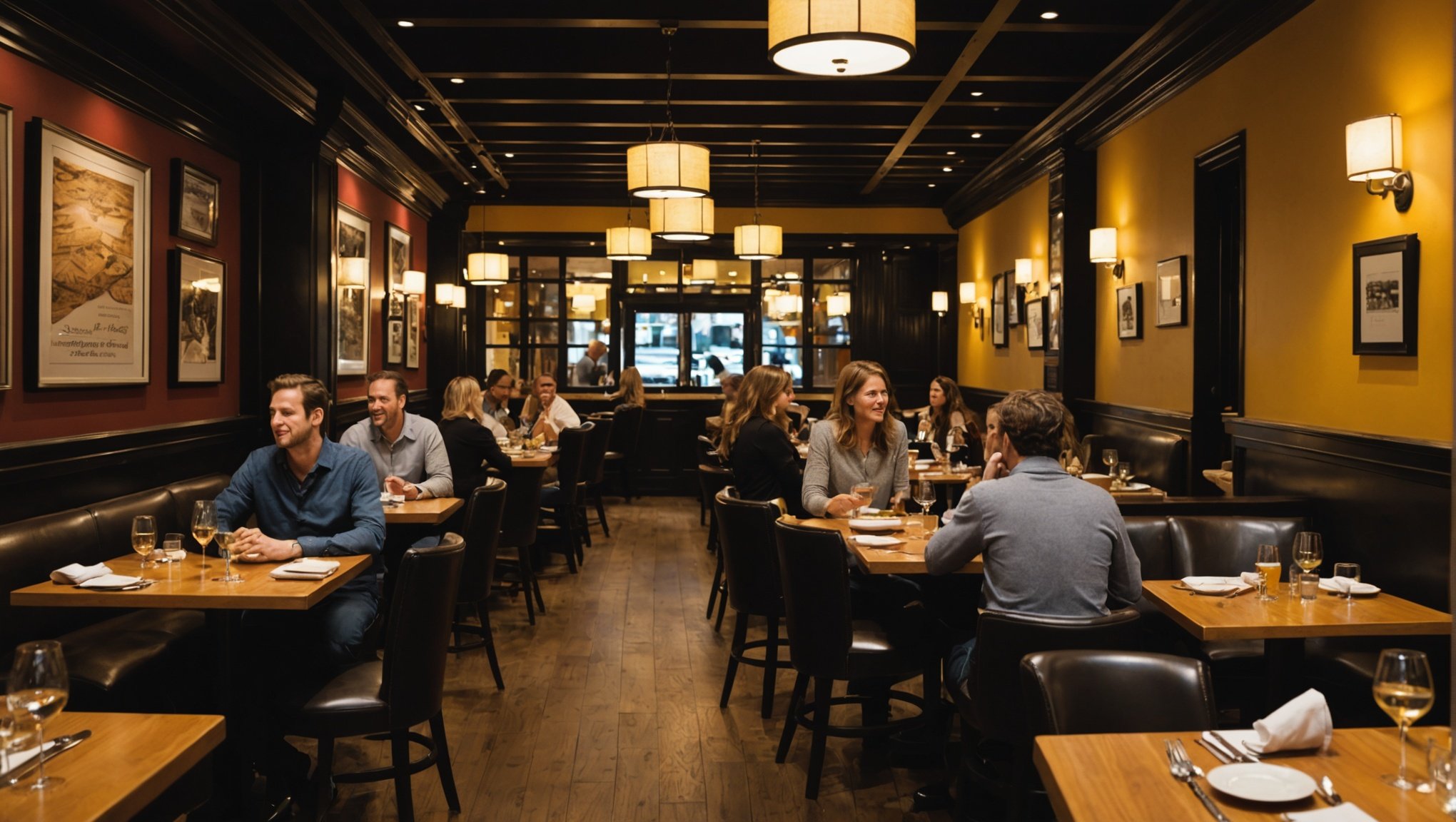The Impact of Restaurant Noise on Customer Satisfaction: Unraveling the Connection
When you step into a restaurant, the ambiance is just as important as the food on your plate. One often overlooked but crucial aspect of this ambiance is the noise level. Noise can significantly influence your dining experience, affecting everything from your ability to taste the food to your overall satisfaction with the service. Let’s delve into the complex relationship between restaurant noise and customer satisfaction.
The Science Behind Noise and Taste
Studies have shown that noise can have a profound impact on our perception of food and drink. A publication on ResearchGate highlights that both background noise and loud music can impair our ability to taste food and drink.
Also to see : Boosting Family Restaurant Engagement: The Power of Interactive Tabletop Games
How Noise Affects Flavor
When we eat, our senses work together to create the full flavor experience. Noise can disrupt this harmony. Here are some key points to consider:
- Masking Flavors: Loud noise can mask the subtle flavors of food, making it harder to distinguish between different tastes.
- Stress and Anxiety: High noise levels can increase stress and anxiety, which in turn can affect our digestive system and our ability to enjoy the meal.
- Attention Diversion: Noise can divert our attention away from the food, reducing the overall enjoyment of the dining experience.
For instance, imagine dining in a quiet, intimate setting versus a bustling, noisy environment. The quiet setting allows you to focus on the flavors and textures of your food, enhancing your overall dining experience.
Also to see : Selecting the Perfect Tableware: A Guide to Enhancing Your Restaurant”s Theme
The Role of Noise in Customer Satisfaction
Customer satisfaction is multifaceted, and noise is one of the important factors that can make or break a dining experience.
Creating the Right Ambiance
Restaurants aim to create an ambiance that makes customers feel comfortable and valued. Here’s how noise fits into this equation:
- Comfort Level: Moderate noise levels can create a welcoming atmosphere, making the restaurant feel lively but not overwhelming. However, excessive noise can make the environment uncomfortable.
- Social Interaction: Noise levels can influence social interactions. A moderate level of noise can facilitate conversation, while too much noise can make it difficult to talk.
- Service Quality: High noise levels can also affect the service quality. Staff may struggle to communicate effectively, leading to mistakes and delays.
For example, a restaurant like a cozy Italian trattoria might aim for a warm and inviting ambiance with soft background music, while a fast food restaurant might have a more energetic and lively atmosphere.
Practical Solutions for Noise Management
Managing noise levels is crucial for maintaining customer satisfaction. Here are some practical solutions restaurants can implement:
Acoustic Panels and Baffles
Acoustic panels and baffles are effective tools for noise suppression. Here’s a comparison of the two:
| Feature | Acoustic Panels | Acoustic Baffles |
|---|---|---|
| Placement | Typically mounted on walls or ceilings | Suspended from the ceiling |
| Effectiveness | Excellent for absorbing sound waves | Good for both absorption and diffusion |
| Aesthetics | Can be designed to match the decor | Often more visible but can be decorative |
| Cost | Generally more affordable | Can be more expensive depending on design |
Acoustic panels are versatile and effective, making them a popular choice for many restaurants. However, acoustic baffles offer the added benefit of diffusion, which can help distribute sound more evenly.
AI-Driven Noise Management
Advanced technologies, such as AI, are also being used to manage noise levels in restaurants. Here’s how AI can help:
- Real-Time Adjustments: AI systems can analyze the noise level in real-time and adjust the music or activate sound-dampening systems to maintain comfortable conversation levels.
- Predictive Analytics: By analyzing historical data and real-time information, AI can predict and prevent potential disruptions, ensuring a smooth and relaxed atmosphere.
For instance, an AI system might detect that the noise level is rising during a busy happy hour and automatically adjust the music volume to maintain a comfortable level.
Customer Behavior and Consumption
Noise levels can influence customer behavior and consumption patterns in several ways.
Dining Experience and Food Choice
- Mood Influence: The ambiance, including noise levels, can affect a customer’s mood, which in turn influences their food choices. A relaxed atmosphere might encourage customers to try more elaborate dishes, while a noisy environment might lead them to opt for quicker, simpler meals.
- Consumption Speed: Noise can also affect how quickly customers eat. In a noisy environment, customers might eat faster to escape the discomfort, while in a quiet setting, they might linger longer over their meal.
Social Interaction and Word of Mouth
- Social Engagement: Moderate noise levels can facilitate social interaction, making the dining experience more enjoyable and increasing the likelihood of positive word of mouth.
- Online Reviews: Customers who have a pleasant dining experience, partly due to well-managed noise levels, are more likely to leave positive online reviews, which can attract more customers.
Long-Term Impact on Customer Loyalty
The impact of noise on customer satisfaction is not just immediate; it also has long-term implications for customer loyalty.
Customer Loyalty and Retention
- Repeat Business: Customers who feel comfortable and valued in a restaurant are more likely to return. Consistent noise management is key to creating this positive experience.
- Recommendations: Satisfied customers are more likely to recommend the restaurant to friends and family, which can lead to increased business and a stronger reputation.
As one restaurant owner noted, “When customers feel at home in our restaurant, they come back. And when they come back, they bring their friends and family. It’s all about creating that perfect ambiance, and noise management is a critical part of that.”
The connection between restaurant noise and customer satisfaction is complex and multifaceted. By understanding the science behind how noise affects our perception of food and by implementing practical solutions for noise management, restaurants can significantly enhance the dining experience.
Here are some key takeaways:
- Noise Affects Taste: High noise levels can impair our ability to taste food and drink.
- Ambiance Matters: The right noise level can create a welcoming atmosphere, while excessive noise can be detrimental.
- AI Can Help: Advanced technologies like AI can manage noise levels in real-time, ensuring a comfortable and enjoyable dining experience.
- Long-Term Benefits: Well-managed noise levels can lead to increased customer loyalty and positive word of mouth.
In the end, it’s all about creating an environment where customers feel valued and comfortable. As the saying goes, “A happy customer is a returning customer,” and managing noise levels is a crucial step in achieving that happiness.
Additional Tips for Restaurant Owners
Here are some additional tips to help you manage noise levels effectively:
Conduct Regular Noise Audits
- Regularly assess the noise levels in your restaurant to identify areas that need improvement.
Use Feedback
- Collect feedback from customers and staff to understand how noise levels are impacting their experience.
Train Staff
- Train your staff to be aware of noise levels and to take steps to manage them, such as adjusting music volume or using noise-suppression tools.
Invest in Technology
- Consider investing in AI-driven noise management systems to ensure real-time adjustments and optimal ambiance.
By taking these steps, you can create a dining environment that not only satisfies but also delights your customers, ensuring long-term loyalty and success in the competitive restaurant industry.






